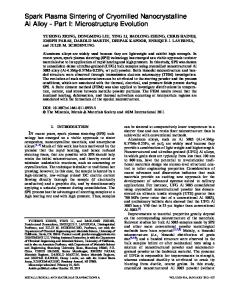Spark Plasma Sintering of Nanostructured Aluminum: Influence of Tooling Material on Microstructure
- PDF / 771,763 Bytes
- 9 Pages / 593.972 x 792 pts Page_size
- 25 Downloads / 298 Views
NTRODUCTION
SPARK plasma sintering (SPS) is a recently developed powder consolidation technology that is capable of being applied to metals, alloys, ceramics, and composites.[1–3] In SPS, a pulsed high-amperage, direct current is used concurrently with a superimposed uniaxial pressure to consolidate powders. In comparison with well-established consolidation methods such as hot pressing, where the samples are heated externally, the thermal energy during SPS is generated in situ, i.e., by the mold elements, as well as by the powder being sintered in case of conductive powder. This technique possesses the advantage of sintering samples under conditions of high heating rate [up to 1000 K/minutes (1000 °C/minutes)] and high pressures (up to 1000 MPa), which also depend on the mold material and sintering temperature used. Consequently, materials can be consolidated at relatively low temperatures and under shorter time intervals, thereby minimizing changes to the starting microstructures, relative to conditions generally present during conventional consolidation methods.[1,3,4] There is a wide body of literature showing that SPS process conditions significantly influence the microstructure of the consolidated material and thereby DONGMING LIU, Associate Professor, is with the Department of Materials Science and Engineering, Shandong University, Jinan, 250061, China. YUHONG XIONG and YING LI, Post-Doctoral Researchers, TROY D. TOPPING, Ph.D. Candidate, YIZHANG ZHOU, Associate Researcher, JULIE M. SCHOENUNG, Professor, and ENRIQUE J. LAVERNIA, Distinguished Professor, are with the Department of Chemical Engineering and Materials Science, University of California Davis, Davis, CA, 95616. Contact e-mail: [email protected] CHRIS HAINES, Senior Metallurgist, JOSEPH PARAS, Materials Engineer, DAROLD MARTIN, Senior Materials Engineer, and DEEPAK KAPOOR, Group Leader, are with the Powder Metallurgy & Particulate Technology, US Army, TACOM-ARDEC, Picatinny, NJ 07806 Manuscript submitted April 16, 2012. Article published online November 13, 2012 1908—VOLUME 44A, APRIL 2013
mechanical response.[5–7] Not surprisingly, numerous investigators have sought to optimize process parameters via studies aimed at understanding densification mechanisms. In related work, Zadra et al. found that temperature and pressure work together to enhance the neck growth between the powder particles and the application of the sintering pressure at high temperature is beneficial to the improvement of mechanical property of the consolidated aluminum samples in comparison with that at room temperature.[8] Santanach et al. investigated the influence of SPS consolidation parameters on a-Al2O3 powder (0.14 lm) and proposed that sintering can be divided into two stages: densification without grain growth at lower temperatures and grain coarsening with further densification at higher temperatures.[9] The results of Munir et al. showed that an electrical current can accelerate the solid state reaction between Mo and Si, but the growth rate of the product phases, which ar
Data Loading...











